
Topics
Guests
- Yajaira Lopezthe older sister of Christian Gomez, a 27-year-old man who died while on a hunger strike at the Corcoran State Prison in California. Gomez died six days after he and 31 other inmates in the prison’s Administrative Segregation Unit began refusing food to protest restrictions on access to adequate healthcare, nutritious food, and legal services.
- Carol Strickmanstaff attorney at Legal Services for Prisoners with Children and a member of the Prisoner Hunger Strike Solidarity Coalition.
Questions are mounting over the state of California’s prison system following the death of a hunger-striking inmate protesting conditions behind bars. Christian Gomez, 27, died at Corcoran State Prison, just six days after he and about 30 fellow prisoners began refusing food. Gomez was one of thousands of California inmates who have staged hunger strikes in 12 prisons since July after the U.S. Supreme Court ruled that California prison overcrowding was causing “needless suffering and death” and ordered the state to reduce its number of prisoners. We speak with Gomez’s sister Yajaira Lopez and to attorney Carol Strickland of the Prisoner Hunger Strike Solidarity Coalition. “When he did get [to Corcoran State Prison], he did explain to us that he was participating in a hunger strike,” Lopez says. “They were fighting for just fair treatment.” [includes rush transcript]
Transcript
JUAN GONZALEZ: We begin today’s show in California, where family members of a prisoner who died while he was on hunger strike are calling for an investigation. Christian Gomez was 27 years old. He died February 2nd at the Corcoran State Prison, just six days after he and about 30 fellow prisoners began refusing food. They were protesting limited access to legal services, telephones, laundry, nutritious food, health services, and educational opportunities.
This is California Department of Corrections spokeswoman Terry Thornton.
TERRY THORNTON: On February 2nd, inmate Gomez was found unresponsive. He was pronounced dead at an outside hospital at 12:22 p.m. on February 2nd. I’d like to point out that he was receiving medical treatment prior to his participation in this hunger strike. And additionally, he, as well as all the other inmates, were being medically monitored daily during the hunger strike. The Kings County coroner—that’s the county where Corcoran State Prison is located—conducted an autopsy, but we have not received a cause of death. We are still waiting for that. It is up to the county coroner to make that determination. They have not yet made that determination. And so, we’re very anxiously awaiting that, as well.
JUAN GONZALEZ: That was California Department of Corrections spokeswoman Terry Thornton.
Christian Gomez’s family members say they were told he died of health complications, and only later learned he was on a hunger strike. He was serving a life sentence for first-degree murder and attempted murder and was being held in the prison’s Administrative Segregation Unit.
AMY GOODMAN: Christian Gomez was one of thousands of California prisoners who have staged hunger strikes in 12 prisons since July, starting with protests against isolation units at Pelican Bay, California’s first super-maximum security prison. The strikes began after the U.S. Supreme Court ruled last May that California prison overcrowding is causing, quote, “needless suffering and death” and ordered the state to reduce its number of prisoners.
On Monday, Occupy demonstrators held a nationwide day of action against the U.S. prison system. Protests were held at prisons in California, Chicago, Denver and New York. Outside San Quentin prison in California, the American hikers, who were recently released from prison in Iran—Sarah Shourd, Josh Fattal and Shane Bauer—spoke about how public pressure led to their release. This is Shane Bauer.
SHANE BAUER: The biggest victories came when there was pressure from the outside. Prisons function on the ability to completely control a small, self-contained world. But when that world stops being self-contained, when people inside are coordinated with people outside, that system of control falls apart. When our families and Sarah publicly hunger struck on the outside in solidarity with us on the inside, we started receiving all of our letters. We got a phone call, and books from our families came without delay. And then we got freed. This movement, this Occupy movement, needs to permeate the prisons.
AMY GOODMAN: Shane Bauer and Josh Fattal were recently released from an Iranian prison after more than two-and-a-half years there.
Well, for more on the death of hunger striker Christian Gomez and the state of prisons in California and beyond, we turn now to two guests. In Los Angeles, we’re joined by Christian’s older sister, Yajaira Lopez. And in Berkeley, California, we’re joined by Carol Strickman, staff attorney at Legal Services for Prisoners with Children and a member of the Prisoner Hunger Strike Solidarity Coalition.
Yajaira and Carol, we welcome you both to Democracy Now! Yajaira, what do you understand happened to your brother, to Christian?
YAJAIRA LOPEZ: From what the county—from what the coroner told us, he told us that he was participating in the hunger strike and that there—he told us there could be various causes. It could have been a chemical imbalance due to the hunger strike. It could have been another medical condition. But he couldn’t pinpoint the cause of death until further investigation is conducted.
JUAN GONZALEZ: And you say the corner told you he was participating in a hunger strike. What did prison authorities tell you?
YAJAIRA LOPEZ: Oh, we couldn’t get through to them. That day that they called my mother and told them that he was deceased, they told her that he died of medical conditions. They couldn’t tell her anything further. But that was pretty much it.
AMY GOODMAN: Can you tell us about your brother? Where was he born? Talk about how he ended up in prison.
YAJAIRA LOPEZ: He was born in Los Angeles, California. We were born and raised by our two parents. We grew up in Echo Park. You know, it’s not such a great neighborhood, but we grew up there. You know, we both went to school. He started hanging out with the wrong crowd, but, you know, he was always close with his family, always, you know, dedicated. And, you know, he loved sports. He just—you know, he got accused of murder. You know, the system failed him, and he ended up where he was at.
JUAN GONZALEZ: Now, had you been in much contact with him? Had he been talking to you or other members of your family about the conditions in the prison?
YAJAIRA LOPEZ: We would always go visit him. We went at least, you know, twice a month since he was there. He had been in prison for seven years. He was arrested when he was 20, a week before he turned 21. We would go see him at the jails. We went to see him when he was at High Desert State Prison. He was there for about three to four years, and then he was moved to Corcoran for six months, where he lasted six months.
He would—he would tell us, you know, they—fair treatment at High Desert State Prison. When he got moved to Corcoran, he did tell us that it was different. The medical treatment he was receiving at High Desert wasn’t the same. You know, even by us just visiting, we could tell the conditions were different. The prison wasn’t as clean as the other one. The way families were treated, it was a lot different. The environment was different. But yeah, when he did get there, he did explain to us that he was participating in a hunger strike. You know, they were fighting for just fair treatment, basically. You know, they wanted their medical treatment, basically.
AMY GOODMAN: California Department of Corrections spokesperson Terry Thornton said Christian Gomez was put in administrative segregation, also known as “ad-seg,” because he was dangerous. This is what she told Democracy Now!
TERRY THORNTON: Inmate Gomez was 27 years old, as I said, and he was serving a life sentence for first-degree murder and attempted first-degree murder since February 22nd of 2008. And that conviction was from Los Angeles County. He had been housed in Corcoran State Prison’s Administrative Segregation Unit since January. He was awaiting a disciplinary decision for a January 14th battery on an inmate with a deadly weapon with serious bodily injury.
AMY GOODMAN: Yajaira Gomez, your response?
YAJAIRA LOPEZ: When I heard this, when I read this, I was very—you know, my family was enraged, because my mom actually went to visit him on January 14th. We got a call afterwards letting us know that he was put there, along with other inmates, because of what occurred. A lot of inmates were taken because they had either blood splatter or they were near the scene. But they confirmed with us, other family members, also his cellmate, and, you know, he wrote us letters letting us know, “You know what? I should be out. You know, I didn’t do anything.” And according to Cisneros, which is also another person that works at the prison, which I spoke to not too long ago, she did confirm that they were under investigation, him along with other inmates. So he didn’t do what they—what she’s saying that he did.
And I just think that, you know, they’re saying—she’s coming out and saying that, you know, it was—and making it seem like he was the only one that was put in there, in segregation, for that, just to make it seem like, oh, he’s a bad person, let’s just—let’s just brush it under the rug. And I don’t think it’s fair. I think everything should come out. And just like I—when I spoke to Cisneros, she told me, you know, “It was under investigation. We didn’t say that your brother was the one that actually committed this.” But, you know, the media likes to twist things around.
JUAN GONZALEZ: Carol Strickman, you’re an attorney who’s been working with Legal Services for Prisoners with Children. Can you talk to us about the—what you know about this particular hunger strike at Corcoran? And also, obviously, we’ve been covering on Democracy Now! for months the various protests across the California prison system.
CAROL STRICKMAN: Yes. What we know about this hunger strike is that there was an initial one at the end of December for about three days. About 60 prisoners participated in that. And I heard at that time that the prison authorities met with the prisoners and agreed to make changes. And I’ve even seen some documentation about changes would happen promptly. And the prisoners, as I understand it, gave the prison three weeks to start delivering on these promises, and nothing happened. And as a result, they resumed their hunger strike on January 27th. And I think it continued through about February 8th. And Christian Gomez died on February 2nd.
AMY GOODMAN: I wanted to get your reaction to another comment from the California Department of Corrections spokesperson Terry Thornton, who told Democracy Now! the prisoners ended their hunger strike February 13th.
TERRY THORNTON: According to California Department of Corrections and Rehabilitation policy, an inmate is considered to be on a hunger strike when that inmate has missed nine consecutive meals. So, on January 27th, 32 inmates, including inmate Christian Alexander Gomez, who was 27 years old, started refusing to eat state-issued food. All of the inmates had resumed eating by February 13th, most of them by February 9th, all of them by February 13th.
AMY GOODMAN: That was the prisons spokesperson. Carol Strickman, do you agree the hunger strike has ended?
CAROL STRICKMAN: Well, I can’t contradict her facts there, but I did hear—we received a letter that some—at least one person may be resuming it. And it’s very difficult to get information out of the prison, and it takes time for letters to get to us. So I can’t say really what’s going on right now.
JUAN GONZALEZ: And what are California state authorities doing? They’re supposedly under a court order to reduce the prison population, yet, with their three-strikes law, they’re almost guaranteed to continue to increase the long-term prison population.
CAROL STRICKMAN: That’s right. That’s right. They are reducing population, but there will remain the issue of far too many people under extremely long sentences. That’s a whole other campaign that has to be fought.
AMY GOODMAN: How unusual is it for a prisoner to die on hunger strike? And Carol Strickman, can you talk about why the word did not get out, what had happened, for days?
CAROL STRICKMAN: OK, as this is the first direct death of a prisoner who was currently on hunger strike that I’m aware of in California in the recent period, word—it’s very difficult for us to get information about serious incidents like this. There was this death. There have been a few suicides also, or alleged suicides, that we have heard about. Typically, it takes—we hear about this through a letter, through a visit. Someone, a family member or a legal person, will visit, and then the word will go around. And I did hear about this death a few days after it happened. And, you know, it basically was “mum’s the word.” I went up to Sacramento and talked to some legislators and said what I had heard, but I—and I think they had heard, too, but there was no public announcement. And I think CDCR would just as soon no one know.
And that’s one of the big problems with this whole area of prison rights work, which is that the information is very difficult to come by, and it’s controlled in large degree by the prison system. So one thing we’re calling for is increased access to prisoners by not only advocates, family members, the legislature and the media. Right now there’s—it’s impossible for media to go speak to the person that they want to speak to, or even a hunter striker, in general. CDCR can prevent that, by law. And there is currently a bill in the legislature, AB 1270, that would change that. And we’re hopeful that that will pass and be signed into law so that you and other media sources can get quicker, more accurate information about what’s going on.
JUAN GONZALEZ: And the particular demands of the inmates at Corcoran who launched this hunger strike?
CAROL STRICKMAN: You’re asking me about the particular demands?
JUAN GONZALEZ: Right, if you—
CAROL STRICKMAN: Yes. Well, these prisoners were in administrative segregation, as you said, which is shorthand as “ad-seg.” That’s a kind of a gateway or a waiting room sometimes to the secured housing unit, where long-term solitary confinement happens. So their demands were focused on the fact that they are often found automatically guilty by untrained hearing officers. And once they’re found guilty, they’re going to be serving, of course, a harsher time inside. When they finish that time, they’re held in—unnecessarily even longer. So they were protesting excess punishment. And that punishment, that excess punishment or extended periods, unauthorized extended periods, are—has been investigated by the attorney general’s office and identified as a problem here.
They’re concerned about medical care, as was mentioned. And I will say that, despite what Terry Thornton stated to you earlier, we were hearing that people were not getting medical care who were on hunger strike and that that’s been something that we saw previously, as well, that the medical care is withdrawn, in many ways. Medications are stopped, and people are not being cared for adequately. And one has to ask, how can this man basically drop dead, you know, after only a few days of a hunger strike, when he’s under medical care? If he was seriously ill, he shouldn’t have been in ad-seg; he should have been in a medical facility. So, I really challenge that.
They also need access to a law library. They have legal cases going on, whether it’s their criminal conviction or something having to do with child custody or visitation issues or any other number of things. They have—very difficult to get access. They have, I understand, one computer that has the law library on it, but to be shared by 200 prisoners. There’s no copy machine in the law library.
So, they need access to phone. There’s no phone calls are allowed in either ad-seg or in the secured housing units, the SHU, where the hunger strike last year occurred. These people are highly isolated. They need to be able to contact their families and legal assistance.
AMY GOODMAN: Carol Strickman, we want to thank you for being with us. We will certainly continue to follow this case, as well as the Occupy movement around the country that is involved with these protests. Carol Strickman, staff attorney at Legal Services for Prisoners with Children. Yajaira [Lopez], sister of Christian Gomez, the 27-year-old prisoner who died while on hunger strike at Corcoran State Prison in California.
This is Democracy Now!, democracynow.org, The War and Peace Report. When we come back, Occupy the SEC and a, hmm, a very joyous Occupy story. You’ll find out why. Stay with us.


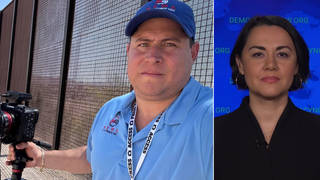
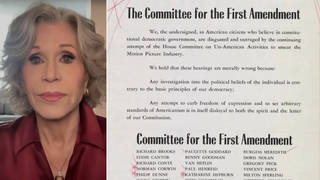




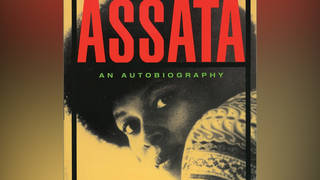

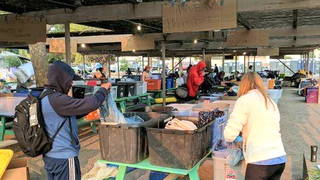

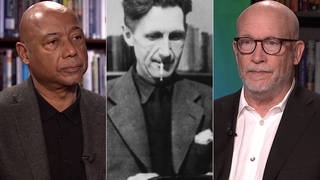
Media Options